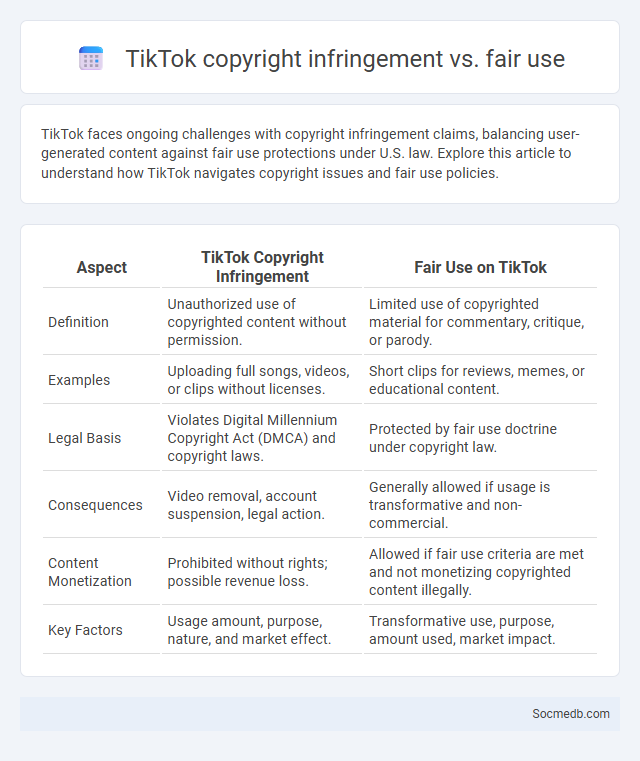
Photo illustration: TikTok copyright infringement vs fair use
TikTok faces ongoing challenges with copyright infringement claims, balancing user-generated content against fair use protections under U.S. law. Explore this article to understand how TikTok navigates copyright issues and fair use policies.
Table of Comparison
| Aspect | TikTok Copyright Infringement | Fair Use on TikTok |
|---|---|---|
| Definition | Unauthorized use of copyrighted content without permission. | Limited use of copyrighted material for commentary, critique, or parody. |
| Examples | Uploading full songs, videos, or clips without licenses. | Short clips for reviews, memes, or educational content. |
| Legal Basis | Violates Digital Millennium Copyright Act (DMCA) and copyright laws. | Protected by fair use doctrine under copyright law. |
| Consequences | Video removal, account suspension, legal action. | Generally allowed if usage is transformative and non-commercial. |
| Content Monetization | Prohibited without rights; possible revenue loss. | Allowed if fair use criteria are met and not monetizing copyrighted content illegally. |
| Key Factors | Usage amount, purpose, nature, and market effect. | Transformative use, purpose, amount used, market impact. |
Understanding TikTok Copyright Basics
TikTok copyright basics center around protecting original content and respecting intellectual property rights to avoid legal issues. You must ensure any music, videos, or images used are either created by you, licensed, or fall under TikTok's royalty agreements. Knowing these rules helps you maintain your account's integrity and avoid copyright strikes or takedowns.
What Constitutes Copyright Infringement on TikTok
Copyright infringement on TikTok occurs when your content uses protected works such as music, videos, or images without permission from the original creator or rights holder. Uploading copyrighted songs, clips, or creative works without proper authorization violates TikTok's policies and copyright laws, leading to potential removal or account penalties. Understanding what constitutes unauthorized use ensures you respect intellectual property rights while sharing content on the platform.
Defining Fair Use in the Context of TikTok
Fair use on TikTok involves the lawful utilization of copyrighted content without explicit permission for purposes such as commentary, criticism, or parody. TikTok's platform policies emphasize transformative use, ensuring original material is meaningfully altered to avoid infringement claims. Understanding fair use requires analyzing factors like the purpose, nature, amount, and effect of content on the original work's market value within TikTok's dynamic social media environment.
Common Examples of Copyrighted Content on TikTok
Common examples of copyrighted content on TikTok include music tracks, movie clips, and TV show excerpts frequently used in user videos. Popular dance challenges often feature copyrighted songs owned by major music labels like Universal Music Group and Sony Music Entertainment. Unauthorized use of trademarked logos, branded products, and copyrighted artwork also constitutes frequent copyright violations on the platform.
Key Differences: Fair Use vs. Copyright Infringement
Fair use in social media allows limited use of copyrighted material for purposes such as commentary, criticism, or education without permission, based on factors like purpose, nature, amount, and market impact. Copyright infringement occurs when content is copied, distributed, or displayed without authorization, violating the owner's exclusive rights and subject to legal penalties. Understanding these distinctions is crucial for social media users to avoid legal risks while leveraging content ethically.
TikTok’s Copyright Policies and Enforcement Mechanisms
TikTok's copyright policies strictly prohibit unauthorized use of protected content, employing advanced AI-driven content identification systems to detect and remove infringing videos. The platform supports Digital Millennium Copyright Act (DMCA) takedown requests, enabling copyright holders to report violations efficiently. Enforcement mechanisms include account penalties, content removal, and repeat infringer bans, ensuring compliance and protecting creators' intellectual property rights.
How Content Creators Can Avoid Copyright Violations
Content creators must prioritize using original material or properly licensed content to avoid copyright violations on social media platforms. Leveraging royalty-free music, images, and videos with clear usage rights ensures your content remains compliant with copyright laws. You should also implement thorough attribution practices and routinely review platform guidelines to safeguard your work from infringement claims.
Legal Consequences of Copyright Infringement on TikTok
Copyright infringement on TikTok can lead to significant legal consequences, including lawsuits, financial penalties, and account suspension or removal. Content creators risk being liable for damages, which may amount to thousands of dollars per infringement under U.S. copyright law, especially when copyrighted music or video clips are used without permission. TikTok employs automated content identification systems to monitor violations, but users must proactively secure licenses or permissions to avoid legal repercussions.
Tips for Claiming Fair Use Defensively on TikTok
To claim fair use defensively on TikTok, focus on transforming original content by adding commentary, criticism, or parody that clearly alters the meaning or message. Use brief clips rather than full-length videos to avoid copyright infringement and provide proper attribution to the original creator when possible. Keeping documentation of the creative process and intent behind the use strengthens the defense if a dispute arises.
Future Trends: Copyright Challenges for TikTok Creators
Future trends in social media spotlight increasing copyright challenges for TikTok creators as the platform's content volume surges. Advanced AI detection tools and stricter copyright enforcement by rights holders compel creators to adopt innovative licensing strategies and original content production to avoid takedown notices. Legislative changes aiming to balance intellectual property protection with user creativity will shape TikTok's evolving digital ecosystem.
 socmedb.com
socmedb.com